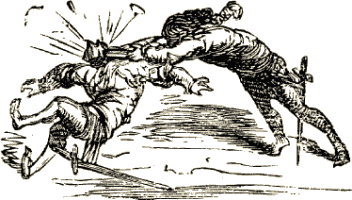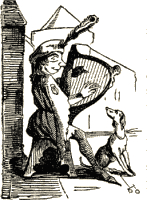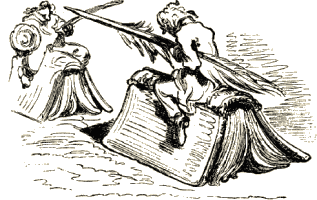Master Niccolby's Hapless Hints on
Building the Objects of the Middle Ages
Special Eastrealm Correspondent to The Quarter
Hint #1 — Document Before You Make an Object

Half the Laurels and Maunches in the East Kingdom were approached the month before the Northern Lights Arts and Sciences Pentathalon by persons wanting help "documenting" the pent entries they had already made. What a waste of time! Only Kingdom Officers are clairvoyant enough to have the information you want on-hand before you ask for it. Don't make anything unless you have thought long and hard about it, and gathered all the appropriate information first. Of course, this requires a certain amount of prescience on your part. Sit yourself down now, and concentrate on next March. What do you see yourself frantically trying to complete on the eve of the Pentathalon? Collect the documentation for it today, and save yourself the heartache of trying to find an open library with both a Xerox machine and an Encyclopaedia Britannica on the way to Albany at midnight.
Hint #2 — Don't Polish Anything Until You're Finished Hitting It
Likewise, don't hem the gown until it hangs right. Don't oil the wood until the carving is done. Don't leap before you look. Don't spit into the wind. Don't throw out the baby with the bathwater. Don't dance with the devil in the pale moonlight (I always tell that to all my apprentices...).
Hint #3 — Don't Trust Other People's Drawings
In fact, don't trust other people much at all. You will notice many Peers holding closely to this truism.
Hint #4 — Make Full Scale Drawings Before You Start
You will find this helps you immensely, as you can hold your object up to the drawing for close comparison. I especially recommend this technique for construction of pavilions, siege engines, and Bayeaux Tapestry reproductions. Ofcourse, I am assuming you are a skilled sketch artist as well as a woodcarver/armorer/ leatherworker/seamstress etc. If not, spend a few years taking drawing classes to polish your skills before you even dare to attempt to make any medieval objects. You'll find it's well worth your time. But be prepared for other people to distrust your sketches (see Hint #3).
Hint #5 — Never Accept as a Fact What Doesn't Make Sense
This should be self-explanatory. However, this hint does not apply to the facts in this document. As a Peer, I am virtually infallible, and you should accept all my statements as gospel.
Hint #6 — Copy, copy, copy

Admit it, there isn't now and never will be a true medieval thought in your body. You can't have an intrinsic feel for how to make medieval objects, so instead of falling into the trap of "self-expression", seek out true medieval artifacts and make exact replicas of them. When the creators are 500 years dead and buried, who could call this plagiarism?
Hint #7 — The Middle Ages is Not Homogenous
In fact, it wasn't even pasteurized, Pasteur having been born far later than the SCA period of study.
Hint #8 — Deal with Your Mistakes
You're working happily along on a project, when you suddenly discover a problem that can't be easily erased. Don't throw it out just because it isn't perfect! You will still learn something by finishing the project. Besides, when you're done, you can sell it off to someone who doesn't know any better. Then they have learned something, too — "Caveat Emptor".
Hint #9 — Tricks of the Trade

Use authentic materials and processes. This will put you more in a medieval frame of mind, and thus help you construct a more truly medieval object. Before you begin, turn off the air conditioner or heater. Light the room with candles, and strew rushes on the floor. Tether your pet goat in one corner of the room, and ask your maiden aunt to sit and complain loudly in another. Now you are approaching a true medieval mindset!
Don't worry if people question your work. The answer to many questions is the same: if you repeat something often enough, and sound convincing, people will come to believe you. It also helps tremendously if you wear a coronet or hold important titles. Practice these refrains:
"How come your shoes have pointy toes?" "Because I say so."
"How come I can't use velcro in my doublet?" "Because I say so."
"How come your table is right, and mine isn't?" "Because I say so."
Hint #10 — Admit Your Ignorance
The really terrible thing about ignorance is you don't know you've got it. Do you learn something new and rush around telling other people how it really was? You fool. It's a good thing for you that I'm here to enlighten you. You know nothing! Admit your ignorance! Surrender to it! There is one source of information, and I am its prophet!
Hint #11 — Trust the Medieval Craftsman
A major failure of the SCA workers in the arts is their inclination to "improve on" the medieval examples. They were painful, they were the wrong color, they didn't work well or were just plain inconvenient.
Don't stray from the examples set you by the craftsman of the Middle Ages. He was just as intelligent as we are today. If he didn't bathe more than twice a year, why should you? Sure, he would have bathed daily if he had running water, but he didn't! Don't take advantage of 20th century conveniences when you're trying to recreate a 10th century object!
Hint #12 — Patience, Humility, and Diligence
I really can't think of much to say on this topic. However, I refer you to related articles such as Machiavelli's "The Prince", Dante's "Inferno", and Prince Edward's "Tourists' Guide to Northern France."
Signed,
Rend, Prattle, and Censor
Master Nicholas Niccolby

